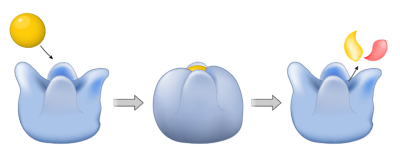By Keith Michael Krise
All living things depend on millions of chemical reactions that happen constantly. Chemical reactions that keep you alive happen fast! When you eat food, breathe, play, and grow, all of these are chemical reactions, and they must take place quickly.
How does your body speed up these important reactions? The answer is enzymes. Enzymes in our bodies are catalysts that speed up reactions by helping to lower the activation energy needed to start a reaction. Each enzyme molecule has a special place called the active site where another molecule, called the substrate, fits. The substrate goes through a chemical reaction and changes into a new molecule called the product — sort of like when a key goes into a lock and the lock opens.
Since most reactions in your body’s cells need special enzymes, each cell contains thousands of different enzymes. Enzymes let chemical reactions in the body happen millions of times faster than without the enzyme. Because enzymes are not part of the product, they can be reused again and again. How efficient!

Enzyme activity measures how fast an enzyme can change a substrate into a product. Changes in temperature or acidity can make enzyme reactions go faster or slower. Enzymes work best under certain conditions, and enzyme activity will slow down if conditions are not ideal. For example, your normal body temperature is 98.6°F (37°C), but if you have a fever and your temperature is above 104°F (40°C), some enzymes in your body can stop working, and you could get sick. There are also enzymes in your stomach that speed up the breakdown of the food you eat, but they are only active when they are in your stomach acid. Each enzyme has a set of conditions where they work best, depending on where they act and what they do.
But what happens if an enzyme is missing or doesn’t work the way it’s supposed to? One example is phenylketonuria (or PKU), a rare inherited disease where the body lacks the enzyme to process proteins. Because of this, toxic molecules can build up, and if they travel to the brain, they may cause severe intellectual disabilities. Infants are all tested for this disease, and if they have it, they need to go on a special diet for life.
Another, less severe, example is lactose intolerance. Many people can digest milk just fine when they are infants or children. But after childhood, many people begin to lose a key enzyme that helps digest milk. If they drink milk, they get terrible stomach pain and diarrhea — all because the enzyme is missing.
Enzymes are important in every living thing. Without them, life as we know it could not, and would not, exist.
Keith Michael Krise, Ph.D. is an Associate Professor of Chemistry at Gannon University, in Erie, PA.

